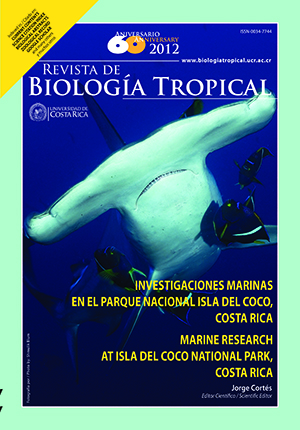Abstract
Isla del Coco is the only land mass of the Cocos Plate that emerges above sea level. This makes it the only place where Cocos Plate motion can be measured using Global Navigation Satellite System (GNSS) monitoring. Global Positioning System (GPS) observations have been carried out sporadically over more than two decades on Isla del Coco, allowing precise measurement of the motion of the Cocos Plate. Recently, in May 2011, a continuous GPS station was built and instrumented at Isla del Coco, in Wafer Bay, by OVSICORI-UNA and UNAVCO, as part of the COCONet regional GNSS network. Position time series from this CGPS station (ISCO: Isla del Coco) show a steady motion of Isla del Coco at a speed of 90.9±1.5mm/yr in the N35oE direction in ITRF2008 and convergence with the Caribbean Plate at 78±1mm/yr. This result is consistent with the findings of the earliest GPS studies, and agrees within uncertainty with the estimated convergence rate of 76.4±x mm/ yr of the MORVEL plate motion model. MORVEL is based on an average over the last 780,000 years, and our result suggests that Cocos-Caribbean plate motions have been constant over that time interval. Citation: Protti, M., V. González, J. Freymueller & S. Doelger. 2012. Isla del Coco, on Cocos Plate, converges with San Andres Island, on the Caribbean Plate, at 78mm/yr. Rev. Biol. Trop. 60 (Suppl. 3): 33-41. Epub 2012 Dec 01.References
Castillo, P., R. Batiza, D. Vanko, E. Malavassi, J. Barquero & E. Fernández. 1988. Anomalously young volcanoes on old hot-spot traces. I. Geology and petrology of Cocos Island. Geol. Soc. Amer. Bull. 100: 1400-1414.
DeMets, C. 2001. A new estimate for present-day CocosCaribbean plate motion: Implications for slip along the Central American volcanic arc. Geophys. Res. Lett. 28: 4043-4046.
DeMets, C., R.G. Gordon, D.F. Argus & S. Stein. 1994. Effect of recent revisions to the geomagnetic reversal time scale on estimates of current plate motions. Geophys. Res. Lett. 21: 2191-2194.
DeMets, C., R.G. Gordon & D.F. Argus. 2010. Geologically current plate motions. Geophys. J. Int. 181: 1-80; doi:10.1111/j.1365-246x.2009.04491.x.
Dixon, T. 1993. GPS Measurement of relative motion of the Cocos and Caribbean plates and strain accumulation across the Middle America Trench. Geophys. Res. Lett. 20: 2167-2170.
Freymueller, J.T., J.N. Kellogg & V. Vega. 1993. Plate motions in the North Andean Region. J. Geophys. Res. 98: 21,853-21,863.
Hey, R.N. 1977 Tectonic evolution of the Cocos-Nazca spreading center, Geol. Soc. Am. Bull., 88: 1404-1420.
Iinuma, T., M. Protti, K. Obana, V. González, R. Van der Laat, T. Kato, S. Miyazaki, Y. Kaneda & E. Hernández. 2004. Inter-plate coupling in the Nicoya Peninsula, Costa Rica, as deduced from a transpeninsula GPS experiment. Earth Planet. Sci. Lett. 223: 203-212.
LaFemina, P., T.H. Dixon, R. Govers, E. Norabuena, H. Turner, A. Saballos, G. Mattioli, M. Protti & W. Strauch. 2009. Fore-arc motion and Cocos Ridge collision in Central America. Geochem. Geophys. Geosyst. 10:Q05S14, doi:10.1029/2008GC002181.
Lonsdale, P.F. & K.D. Klitgord 1978 Structure and tectonic history of the eastern Panama basin, Geol. Soc. Am. Bull. 89: 981-999.
Lundgren, P., M. Protti, A. Donnellan, M. Heflin, E. Hernandez & D. Jefferson. 1999. Seismic cycle and plate margin deformation in Costa Rica: GPS observations from 1994 to 1997. J. Geophys. Res. 104: 28,915-28,926.
Outerbridge, K.C., T.H. Dixon, S.Y. Schwartz, J.I. Walter, M. Protti, V. Gonzalez, J. Biggs, M. Thorwart & W. Rabbel. 2010. A tremor and slip event on the Cocos’ Caribbean subduction zone as measured by a global positioning system (GPS) and seismic network on the Nicoya Peninsula, Costa Rica. J. Geophys. Res. 115: B10408, doi:10.1029/2009JB006845.
Wilson, D.S. 1996. Fastest known spreading on the Miocene Cocos-Pacific Plate Boundary. Geophys. Res. Lett. 23: 3003-3006.
Zumberge, J., M. Heflin, D. Jefferson, M. Watkins & F. Webb. 1997. Precise point positioning for the efficient and robust analysis of GPS data from large networks. J. Geophys. Res. 102: 5005-5017.






